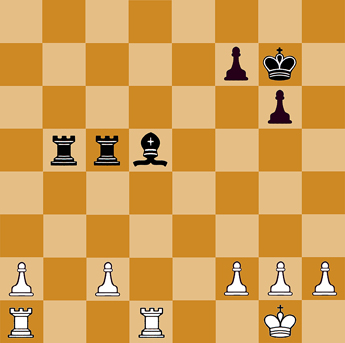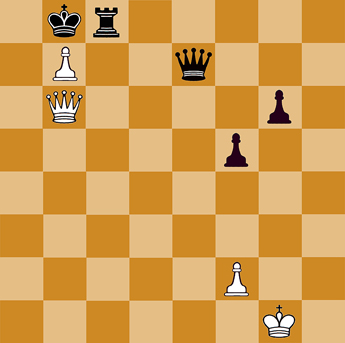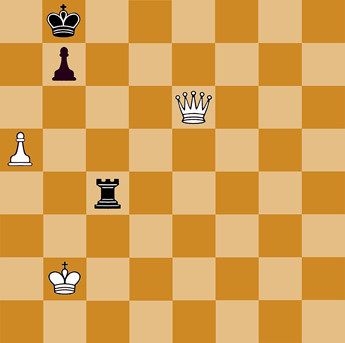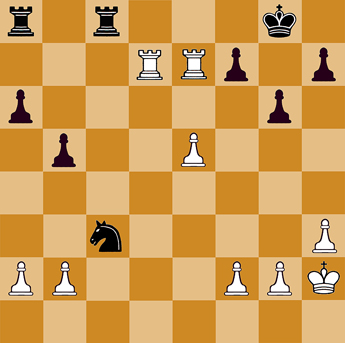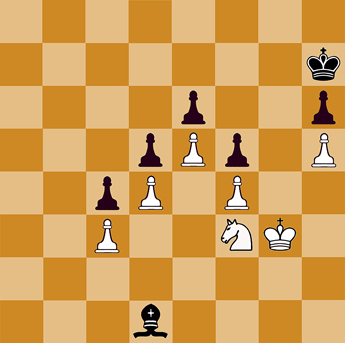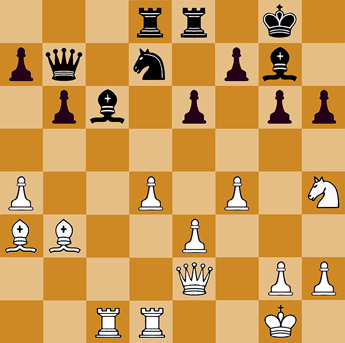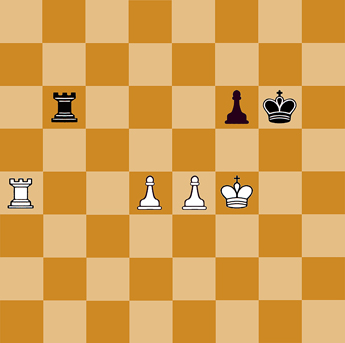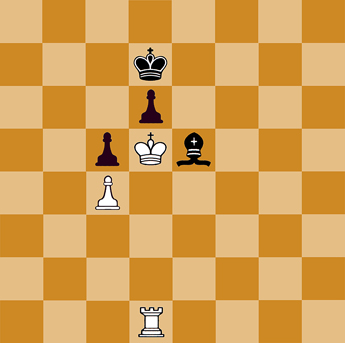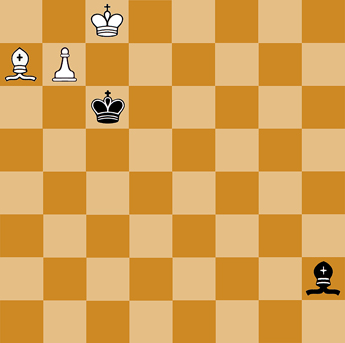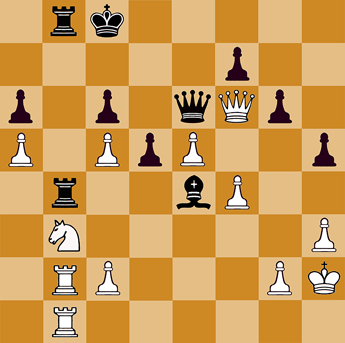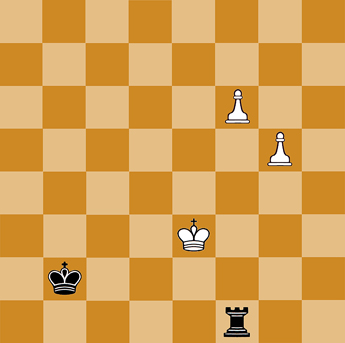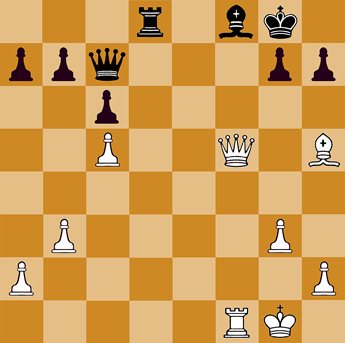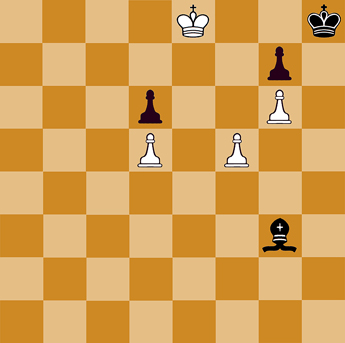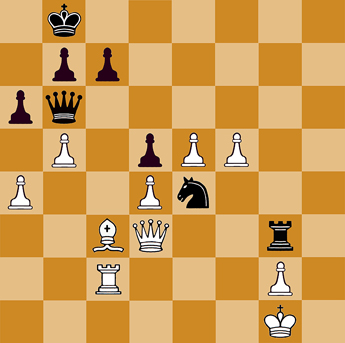|
Task One.
White to move and win. Task Two.
White to win. Task Three.
Black to move and draw. Task Four.
White to move and win. Task Five.
White, with or without the move, draws. Task Six.
White smashes the K side by P-B5.Show this to be so. Task Seven.
How would you win as White? Task Eight.
How would you win as White? Task Nine.
How would you win as White? Each of the following positions offers the opportunity of concluding the game by a series of forcing moves (a “combination”). Attempt to discover the right line of play. Analyze the moves of strong effect directed against vital weaknesses, because that analysis suggests the correct move. There is more internet chess free material below.
Black: Janowski.
White: Mason, to play. White Black 1 Q-R8ch. K-Q2 2 Kt-Q4! R x R 3 Q x R R x Q 4 R x R K-B2! 5 Kt x Qch. K x R 6 Kt-Q4 K-B2 7 P-Kt4 White has sufficient advantage in the end game to force the win by methodical advance by his King. Black: Janowski.
White: Dr. Tarrasch, to play. 1 K-Q4 K-Kt6 If 1 …, R-B4; 2 K-K4, R x KtP; 3 P-B7R-Kt5 ch.; 4 K-K3, R-Kt6 ch.; 5 K-B2 wins. Also 4 K-B3, R-Kt8; 5 K-B2 wins. 2 K-K5 K-B5 3 P-Kt6 R-K8ch. 4 K-Q6 R-KKt8 5 P-Kt7 K-Q5 If now 6 P-B7? R-Kt3 ch.; 7 K moves, R x P draws. 6 K-B6 K-B5 7 K-Q7 K-Q4 8 K-K8 K-K3 9 P-B7 K-QR8 10 P-B8(Kt)ch. K moves 11 P-Kt8 Queens and wins. Black: Bogoljubow.
White: Reti, to play and win.
White to play and win. Put up strong positions with a large degree of movement and experiment with them; you will then be able to discover surprising combinations which you can use to great effect in chess battles. Write out some of your scores of some of your games and attempt to find the last mistake committed, because that one is directly responsible for the result. Repetition will improve your game play over time. The writing of notes for this internet chess free resource will improve over time, and the notes of game play in this e-book are here for the purpose of teaching through experience. Notes taken from master games are of a different standard. You can only comment on master games after you have become a strong player, which takes many lost games and constant practice. Before all, learn to be critical. Many notes published in books, etc are misleading. I cannot go into detail here, but let us take a look at a game from one of the most celebrated matches, that between Mc Donnell and Labourdonnais. Paul Morphy, who beat all the masters of his time, did the notes. Position after Blacks 36th move. Black: Labourdonnais.
White: Mc Donnell. 37 P-R5 Very well played. 37 … Q-R3 R x Q would have won a piece, but could not have saved the game. Suppose 37 …, R x Q; 38 P x Q, Kt x B (or A); 39 R x Kt, R x R; 40 P-B6, and will easily queen one of his pawns. (A) 38 …, R x B; 39 R x R, Kt x R; 40 P-K6 (best), Kt-K5 (best); 41 P-K7, Kt-B3 (best); 42 P-Kt4, K-B1 (best); 43 P x RP (best), P x RP (best). (The line of play beginning with Whites 43rd move is the only road to victory. Should he move 43 P-Kt5, Black would draw by BP x P, and on White capturing the Kt, moving K-Q2. We recommend that the student take note of this sequence, as it can be an advantage in game play. 44 P-Kt7 ch. (best), K x P. (Here again, if White advanced P-Kt5, Black would secure a drawn battle by P x P, and moving K-Q2 on P x Kt); 45 P-Kt5, Kt-K1. (The advance of the KtP now forces the game, the Black K having been removed one square by the sacrifice of the QKtP); 46 P-B6, winning. White might also have won by 40 P-B6, also. 38 B-Q2 Q-R6 39 Q-B1 R-Kt1 40 P-B6 Q-R4 41 P-B7 R-KB1 42 P-K6 Kt-Kt6 43 Q-B3 Q-R8ch. 44 K-B2 Kt-K5ch. 45 K-K2 Q-QKt8 46 P-K7 Q x Pch. 47 Q-Q3 Kt-Kt6ch. 48 K-Q1 Resigns. 30th of the match series. This analysis, so beautiful at Whites 37th move, fails to notice the exceeding importance of Blacks 38th move. Black certainly committed a big error there. Labourdonnais, fatigued by Mc Donnells strong resistance, which in those days no other master could have done, chose a line of attack that hampered the degree of movement of his Rook and lost an all-important move. He should have placed his Q either on KR2, where it confidently stood and threatened the K, the KBP, the Q and the R; or on KR4, a strong position, although not as strong as the first option. In reply to 38 …, Q-R4, White has to reply 39 B-K3, with the possible continuation 39 P x P; 40 R-B2; or 40 P-B6, R-Kt1; 41 K-B1. Against 38 …, Q-R2, White has the choice between 39 B-K3, P x P; 40 R-B2, Kt x R; 41 K x Kt, R-Kt5, which leaves the KBP pinned and the K exposed; or 39 Q-B1, R-Kt1; 40 Q-B3, Kt-Kt6, when White probably would try the desperate course 41 P-B6. This position is interesting and should be remembered by my students of this internet chess free resource, as well as experienced players. After a little while you will gain insight into strong, weak, etc moves and their effects, as well as gain enthusiasm by creating and discovering new series of moves that bring a mate at higher and higher levels. The previous example between two masters shows, that we are all human and even the best can make grave errors in game play, so lost games and errors on your part should be taken lightly. In the information available to me, l have not found criticism on Blacks 38th move, although it appears to be the decisive mistake. This mistake stands out more because of the master game status and that it was played almost two centuries ago. For these reasons it has attracted worldwide attention. We now have a hundred players who would prefer 38 …, Q-R2 or Q-R4 to Q-R6 unhesitatingly.
|
